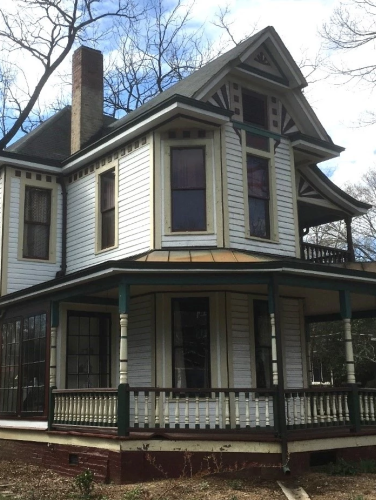
Mallonee-Jones House
(ca. 1895)
The C. C. Hook designed Mallonee-Jones House was constructed for local building contractor J. M. Mallonee.
400 E Kingston Ave, Charlotte, NC 28203
Completed in 1895, the Mallonee-Jones House is one of the earliest homes in Dilworth, Charlotte’s first streetcar suburb that opened in May 1891. Named for Edward Dilworth Latta (1851-1925) – president of the Charlotte Consolidated Construction Company (known as the 4 C’s), the local company primarily responsible for developing the new neighborhood – Dilworth revolutionized the built environment of Charlotte. The Mallonee-Jones House is one of two extant Queen Anne style houses in Dilworth designed by Charles Christian Hook (1870-1938), the first professional architect to live in Charlotte. The 4 C’s hired Hook to design many of Dilworth’s early houses. His other Queen Anne house in Dilworth is the Robert J. Walker House (1901) at 329 East Park Avenue.
Property Quick Links
The house was constructed for Julius Morris Mallonee (1867-1907), a native of Charleston, South Carolina, where his father owned a large lumber business. A graduate of Eastman Business College in Poughkeepsie, New York, J. M. married Emma McRae (1868-1943) of Marlborough County, South Carolina, in 1893. The couple soon moved to Charlotte so that J. M. might establish himself as a building contractor. The Mallonee family resided in the Kingston Avenue home only briefly, selling the Dilworth house in 1897 to move to a new residence on East Fourth Street at the present site of the old Mecklenburg County Courthouse. As a developer, J. M. purchased lots and constructed houses for sale throughout the growing city. He built many of the older homes in Elizabeth, another early Charlotte streetcar suburb, as well as the city’s first apartment complex, Mallonee Flats located across from his Fourth Street home. J. M. was also the building contractor for the Dilworth Graded School that open in 1905. The Mallonees raised seven children.
Hook, a graduate of Washington University in St. Louis, moved to Charlotte in 1891 to teach mechanical drawing in the Charlotte Graded School. He began working for the 4 C’s within one year of his arrival. Hook is credited with introducing the Colonial Revival style into Charlotte’s built environment. Over his career, Hook designed some 800 to 1,000 homes and buildings across the Carolinas, including Charlotte’s U.S. Post Office and Courthouse, Charlotte City Hall, the Carolina Theater, three local fire stations, and several buildings on college campuses across North Carolina (including the Chapel Hill and Greensboro campuses of the University of North Carolina, Davidson College, and N.C. State, Duke, and Queens Universities).
Charles Wellington Jones (1865-1924) and his wife Cora Shepherd Jones (1873-1974) purchased the Mallonees’ Dilworth house as newlyweds in 1899. A native of Harrisonburg, Virginia, Charles had moved to Charlotte in 1895 as a bachelor and established the “Moore & Jones” grocery store before becoming an official of the 4 C’s. He also established the Industrial Bank of Mecklenburg. Cora lived in the Kingston Avenue house following Charles’ death in 1924 until she passed away fifty years later. A graduate of Stuart Hall in Staunton, Virginia, Cora was a history teacher for thirty-three years, first at the D. H. Hill School and later at the Alexander Graham Junior High School on East Morehead Street. Charles and Cora raised three children in their Dilworth home. Local attorney Mercer J. Blankenship Jr. purchased the house in 1974.

